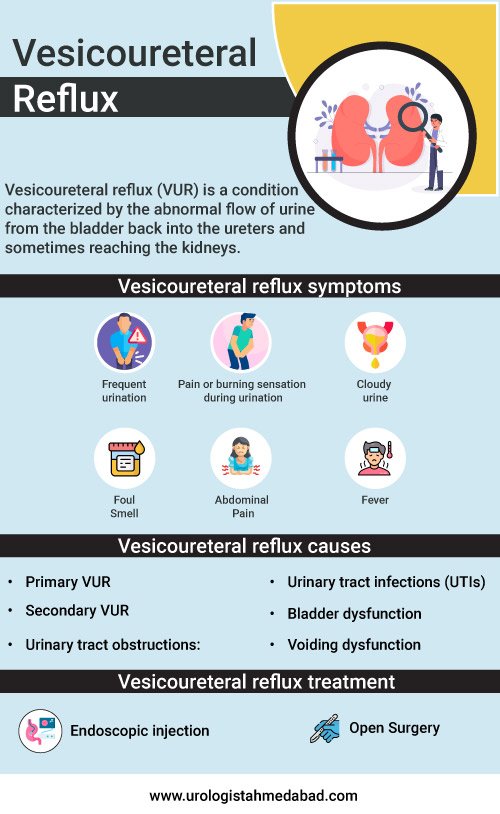Welcome to our comprehensive blog on vesicoureteral reflux (VUR), a condition that affects the urinary system, particularly in young children. If you or a loved one has been diagnosed with VUR or if you’re simply curious to learn more about this condition, you’ve come to the right place.
Vesicoureteral reflux is a medical term used to describe the backward flow of urine from the bladder into the kidneys. This abnormal flow can potentially lead to serious complications such as kidney infections and kidney damage. It is vital to understand the symptoms, causes, and treatment options associated with VUR to ensure timely diagnosis and appropriate care.
In this blog, we will explore the common symptoms that may indicate the presence of vesicoureteral reflux, delve into the underlying causes and risk factors, and discuss the various treatment strategies available. We aim to provide you with a well-rounded understanding of this condition so that you can make informed decisions and take necessary precautions.
It’s important to note that while vesicoureteral reflux primarily affects children, it can also occur in adults. Therefore, regardless of age, the information shared in this blog will be valuable to anyone seeking knowledge about this condition.
Understanding vesicoureteral reflux can empower you to recognize the signs, seek appropriate medical attention, and actively participate in your or your child’s treatment journey. So, let’s dive in and explore the world of vesicoureteral reflux together.

Table of Contents
Vesicoureteral reflux
Vesicoureteral reflux (VUR) is a condition characterized by the abnormal flow of urine from the bladder back into the ureters and sometimes reaching the kidneys. Normally, urine flows in one direction, from the kidneys to the bladder through the ureters. However, in individuals with VUR, urine flows backward, which can lead to potential complications.
Urinary reflux
Urinary reflux is a broad term that can refer to any abnormal backward flow of urine within the urinary system. The term can encompass various conditions, including vesicoureteral reflux (VUR), which specifically refers to the backward flow of urine from the bladder into the ureters. Urinary reflux can have various causes, including anatomical abnormalities in the urinary system, bladder dysfunction, and urinary tract obstructions. It can occur in both children and adults, although VUR is more commonly seen in children. The symptoms, complications, and treatment options for urinary reflux depend on the specific type and severity of the condition. It is important to consult with a healthcare professional for an accurate diagnosis and appropriate management based on individual circumstances.
Vesicoureteral reflux treatment
The treatment of vesicoureteral reflux (VUR) depends on several factors, including the severity of the condition, the age of the patient, the presence of symptoms, and the risk of complications. The goal of treatment is to prevent urinary tract infections (UTIs), preserve kidney function, and minimize the risk of long-term complications. Here are some common treatment options for VUR:
- Antibiotic prophylaxis: This involves taking low-dose antibiotics daily to prevent UTIs. Antibiotics help prevent bacterial growth in the urinary tract and reduce the risk of kidney infections. Regular urine tests and periodic imaging studies are usually conducted to monitor the effectiveness of the antibiotic treatment.
- Surgical intervention:
-
- Endoscopic injection: This minimally invasive procedure involves injecting a bulking agent, such as Deflux or Macroplastique, into the tissue around the ureter-bladder junction. The bulking agent helps to create a valve-like effect, preventing urine from flowing back into the kidneys. Endoscopic injection is typically recommended for children with mild to moderate VUR.
- Open surgery: In some cases of severe VUR or when the endoscopic injection is not feasible, open surgery may be necessary. The most common surgical procedure is ureteral reimplantation, where the ureter is surgically repositioned and reattached to the bladder, creating a new valve mechanism. Open surgery is usually performed under general anesthesia and may require a hospital stay.
- Monitoring and observation: In some cases, especially for mild VUR that does not cause significant symptoms or complications, close monitoring and periodic testing may be recommended. This approach is often adopted for children who have outgrown their VUR by the age of 5-6 years or those with lower-grade reflux.
The choice of treatment is individualized based on factors such as the severity of reflux, the risk of complications, the age of the patient, and parental preferences. It is important to consult with a pediatric urologist or urologist experienced in managing VUR to determine the most suitable treatment approach for a specific case.
Regular follow-up visits and monitoring are crucial to assess the effectiveness of treatment, detect any recurrence of reflux or complications, and ensure the overall health of the urinary system.
Vesicoureteral reflux symptoms
The symptoms of vesicoureteral reflux (VUR) can vary depending on the severity of the condition and whether it is accompanied by other complications. It is important to note that some individuals with VUR may not experience any symptoms, while others may exhibit signs of urinary tract infections (UTIs) or kidney involvement. Here are some common symptoms associated with VUR:
- Urinary tract infections (UTIs): Recurrent UTIs are often a key indicator of VUR. Symptoms of UTIs in children and adults can include:
- Frequent urination
- Pain or burning sensation during urination
- Cloudy urine or bloody urine
- Foul-smelling urine
- Abdominal pain or discomfort
- Fever
- Kidney infections (pyelonephritis): In more severe cases of VUR, urinary tract infections can progress to kidney infections. Symptoms of pyelonephritis may include:
- High fever
- Flank pain (pain in the lower back or side)
- Abdominal pain
- Nausea and vomiting
- Generalized fatigue or malaise
- Unexplained fever: Some children with VUR may experience unexplained fevers without any obvious signs of infection. These fevers can be an indication of kidney involvement and should be evaluated by a healthcare professional.
It is important to note that these symptoms can also be associated with other urinary conditions, and a proper medical evaluation is necessary for an accurate diagnosis. If you suspect VUR or are experiencing any concerning urinary symptoms, it is recommended to consult with a healthcare professional, such as a pediatrician or urologist, for a thorough evaluation and appropriate management.
Vesicoureteral reflux causes
Vesicoureteral reflux (VUR) can have both primary and secondary causes. Understanding the underlying causes can help in the diagnosis and management of the condition. Here are the main factors that contribute to the development of VUR:
- Primary VUR: This form of VUR is typically present at birth and is thought to result from a congenital defect in the valve-like mechanism where the ureters meet the bladder. The exact cause of primary VUR is not fully understood, but it is believed to be a developmental abnormality. In this case, the valve that normally prevents urine from flowing backward into the ureters and kidneys is either absent or faulty, leading to the reflux of urine.
- Secondary VUR: Secondary VUR can develop later in life as a result of an underlying condition or factor that affects the normal functioning of the urinary system. Some common causes of secondary VUR include:
- Urinary tract infections (UTIs): Infections of the urinary tract, particularly the bladder, can cause inflammation and weaken the valve mechanism, leading to reflux.
- Bladder dysfunction: Conditions that affect the bladder’s ability to empty properly, such as the neurogenic bladder (a dysfunction of the nerves that control bladder function), bladder muscle disorders, or bladder outlet obstruction, can result in VUR.
- Urinary tract obstructions: Blockages or obstructions in the urinary tract, such as urethral strictures, urethral valves, or ureteral strictures, can disrupt the normal urine flow and cause reflux.
- Voiding dysfunction: Certain abnormalities in voiding patterns, such as dysfunctional voiding or holding urine for prolonged periods, can contribute to VUR.
- Other factors: Rarely, certain genetic or hereditary conditions may be associated with an increased risk of VUR.
It is important to note that VUR can occur in individuals of any age, but it is mostly diagnosed in infants and young children. Determining the underlying cause of VUR is essential for proper management and may involve diagnostic tests, such as imaging studies and urodynamic evaluations, to evaluate the structure and function of the urinary system.
Conclusion
In conclusion, understanding vesicoureteral reflux (VUR) is essential for early detection, accurate diagnosis, and appropriate treatment. VUR can present with symptoms like recurrent urinary tract infections and kidney involvement, while some cases may be asymptomatic. The causes of VUR include primary factors, such as congenital abnormalities in the valve mechanism, as well as secondary factors like urinary tract infections, bladder dysfunction, and urinary tract obstructions. Treatment options range from antibiotic prophylaxis and observation to endoscopic procedures or open surgery in more severe cases. Consulting with a knowledgeable healthcare professional, such as Dr. Dushyant Pawar, a trusted pediatrician or urologist specializing in pediatric urology, is crucial for a comprehensive evaluation, personalized treatment plans, and ongoing management of VUR. By staying informed and seeking proper medical guidance, individuals with VUR can effectively manage the condition and promote the long-term health of their urinary system.



